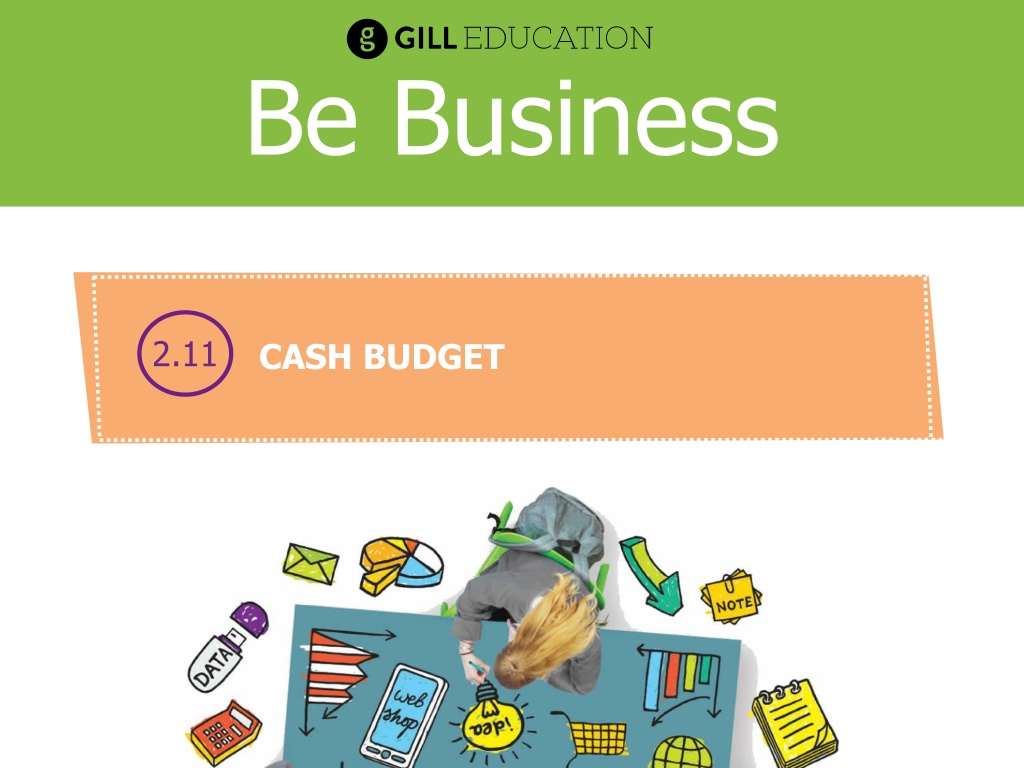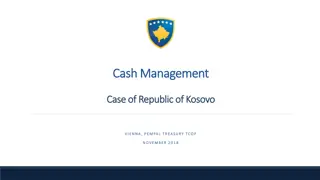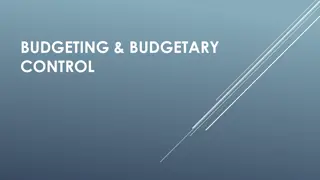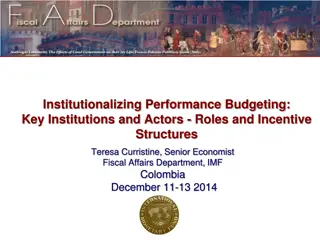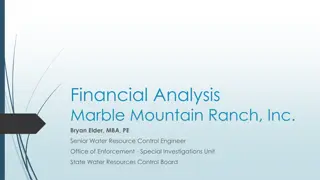Understanding Cash Budgeting for Financial Management
Explore the essentials of cash budgeting in organizations, including the importance of cash flow forecasting, preparation of a cash budget, application of bookkeeping skills, and selection of suitable sources of finance. Learn about the distinction between profit and cash, the significance of record-keeping for managing cash, debtors, and stock, and the role of cash control and credit control in financial stability and decision-making.
Download Presentation

Please find below an Image/Link to download the presentation.
The content on the website is provided AS IS for your information and personal use only. It may not be sold, licensed, or shared on other websites without obtaining consent from the author. Download presentation by click this link. If you encounter any issues during the download, it is possible that the publisher has removed the file from their server.
E N D
Presentation Transcript
Be Business 2.11 CASH BUDGET
CASH BUDGET 2.11 Learning Intentions At the end of this unit I will: Understand the importance to an organisation of preparing a cash budget Be able to prepare a cash budget Be able to apply my bookkeeping skills Value sources of finance and how they are used 2
CASH BUDGET 2.11 3 3
CASH BUDGET 2.11 BEFORE WE BEGIN Do this exercise individually or in pairs. Tick whether you agree or disagree with the statements. Revisit it after the unit to see if you have changed your mind about any of them. Before After I agree I disagree Statement I agree I disagree The cash budget shows the cash flow forecast of an organisation Cash is just as important as profit #04AFEF A cash budget is only useful for not-for profit organisations Individuals, households, organisations and governments must always select a source of finance that matches their needs Sources of finance are all long-term 4
CASH BUDGET 2.11 3Ts = Turn, Think, Talk Profit does not equal cash. Why might that be? Wonderful Worthwhile Website www.sageone.ie 5
CASH BUDGET 2.11 Record Keeping Every organisation needs to know where it stands financially (what money it has). Key questions are: Are we making a profit? How much are we selling? What are our costs? Do we have sufficient cash? These questions can only be answered if the company keeps suitable records on its finances. These records must be correct and timely. 6
CASH BUDGET 2.11 Record Keeping An organisation s record-keeping allows it to manage: 1. Cash 2. Debtors 3. Stock 7
CASH BUDGET 2.11 Record Keeping: Cash An organisation needs cash to: Pay bills Buy materials Cover delays in payments from suppliers Having a cash safety net is vital. This is known as cash control. 8 8
CASH BUDGET 2.11 Record Keeping: Debtors An organisation needs to: Keep track of its debtors people we sell goods to on credit Ensure it doesn t have bad debts debtor who won t or can t pay This is known as credit control. 9
CASH BUDGET 2.11 Record Keeping: Stock An organisation needs to ensure it has sufficientstock. Too much stock is a waste of cash Too little stock could cause the organisation to lose customers Having good stock control is essential. 10
CASH BUDGET 2.11 Cash Budget A cash budget, or cash flow budget, is a tool for managing an organisation s money. It shows: Projected cash coming in Projected cash going out This is usually shown on a month-by-month basis. A cash budget will show when an organisation needs extra money to cover expenditures. 11
CASH BUDGET 2.11 How to Prepare a Cash Budget A cash budget should list all the incoming and outgoingcash items for 12 months. Cash In: Planned/Projected Receipts Cash Out: Planned/Projected Payments Cash sales Cash received from debtors Money invested by owners Selling off fixed assets Loans Grants Cash purchases Cash paid to creditors Money taken out by owners (drawings) Purchasing fixed assets Repaying loan and interest Paying expenses and taxation An organisation deals with cash sales, cash purchases, trade on credit and delayed payments. 12
CASH BUDGET 2.11 How to Prepare a Cash Budget A debtor is someone we sell goods to on credit. They owe us money to pay at a later date. They are an asset. A creditor is someone we buy goods from on credit. We owe them money to pay at a later date. They are a liability. Time to think Why might we sell on credit? Why might we buy on credit? 13
CASH BUDGET 2.11 Six Steps to Creating a Cash Budget 1. Prepare a skeleton template and insert opening cash 2. Record all receipts/cash in and total receipts 3. Record all payments/cash out and total payments 4. Calculate net cash position 5. Calculate planned opening cash 6. Calculate planned closing cash 14
CASH BUDGET 2.11 Example: WildSurf Cash Budget WildSurf is a company selling surfboards on the west coast of Kerry. They have actual cash of 400 at the beginning of the year. We will work through the steps of creating their cash budget for three months, January to March. 15
CASH BUDGET 2.11 CASH BUDGET 2.11 Cash Budget for WildSurf for the three months January to March 20xx January Details February March Total January to March Step 1: Create a skeleton template and insert opening cash Receipts Sales Capital Grant 1. Total Receipts Payments Labour Paint Admin Wages Business Cards Posters Phone Calls Travel 2. Total Payments 3. Net Cash (1 - 2) 4. Opening Cash 5. Closing Cash (3 + 4) 400 16
CASH BUDGET 2.11 CASH BUDGET 2.11 Cash Budget for WildSurf for the three months January to March 20xx January Details February March Total January to March Step 2: Record all receipts/cash in and total receipts Receipts Sales Capital Grant 1. Total Receipts Payments Labour Paint Admin Wages Business Cards Posters Phone Calls Travel 2. Total Payments 3. Net Cash (1 - 2) 4. Opening Cash 5. Closing Cash (3 + 4) 3,000 3,000 1,500 600 5,100 3,000 500 9,000 2,000 600 11,600 3,000 3,500 Sales of 3,000 a month. 1,500 in February and 500 in March from investors. A grant in February of 600. 400 17
CASH BUDGET 2.11 CASH BUDGET 2.11 Step 3: Record all receipts/cash in and total receipts Cash Budget for WildSurf for the three months January to March 20xx January Details February March Total January to March Payments Labour Paint Admin Wages Business Cards Posters Phone Calls Travel 2. Total Payments 1,200 1,200 1,400 400 1,200 1,400 400 3,600 2,800 800 300 100 100 100 7,800 300 100 100 100 1,500 3,100 3,200 18
CASH BUDGET 2.11 Cash Budget for WildSurf for the three months January to March 20xx January Details February March Total January to March Receipts Sales Capital Grant 1. Total Receipts Payments Labour Paint Admin Wages Business Cards Posters Phone Calls Travel 2. Total Payments 3. Net Cash (1 - 2) 4. Opening Cash 5. Closing Cash (3 + 4) 3,000 3,000 1,500 600 5,100 3,000 500 9,000 2,000 600 11,600 3,000 3,500 1,200 1,200 1,400 400 1,200 1,400 400 3,600 2,800 800 300 100 100 100 7,800 300 100 100 100 1,500 3,100 3,200 400 19
CASH BUDGET 2.11 CASH BUDGET 2.11 Cash Budget for WildSurf for the three months January to March 20xx January Details February March Total January to March Step 4: Calculate Net Cash Position Receipts Sales Capital Grant 1. Total Receipts Expenditure Labour Paint Admin Wages Business Cards Posters Phone Calls Travel 2. Total Payments 3. Net Cash (1 - 2) 3,000 3,000 1,500 600 5,100 3,000 500 9,000 2,000 600 11,600 Net cash = total receipts - total payments 3,000 3,500 1,200 1,200 1,400 400 1,200 1,400 400 3,600 2,800 800 300 100 100 100 7,800 3,800 300 100 100 100 1,500 1,500 3,100 2,000 3,200 300 20
CASH BUDGET 2.11 Step 5: Calculate Planned Open Cash Cash Budget for WildSurf for the three months January to March 20xx Details January February March Total January to March 1. Total Receipts 2. Total Payments 3. Net Cash (1 - 2) 4. Opening Cash 3,000 1,500 1,500 400 5,100 3,100 2,000 1,900 3,500 3,200 300 3,900 11,600 7,800 3,800 400 The open cash in Total is the opening cash of January = 400. 21
CASH BUDGET 2.11 Step 5: Calculate Planned Closing Cash Cash Budget for WildSurf for the three months January to March 20xx Details January February March Total January to March 1. Total Receipts 2. Total Payments 3. Net Cash (1 - 2) 4. Opening Cash 3,000 1,500 1,500 400 5,100 3,100 2,000 1,900 3,500 3,200 300 3,900 11,600 7,800 3,800 400 5. Closing Cash (3 + 4) 1,900 3,900 4,200 4,200 The closing cash of January becomes the opening cash of February The opening cash in Total is the opening cash of January 400 22
CASH BUDGET 2.11 Cash Budget for WildSurf for the three months January to March 20xx January Details February March Total January to March Receipts Sales Capital Grant 1. Total Receipts Expenditure Labour Paint Admin Wages Business Cards Posters Phone Calls Travel 2. Total Payments 3. Net Cash (1 - 2) 4. Opening Cash 5. Closing Cash (3 + 4) 3,000 3,000 1,500 600 5,100 3,000 500 9,000 2,000 600 11,600 3,000 3,500 1,200 1,200 1,400 400 1,200 1,400 400 3,600 2,800 800 300 100 100 100 7,800 3,800 400 4,200 300 100 100 100 1,500 1,500 400 1,900 3,100 2,000 1,900 3,900 3,200 300 3,900 4,200 23
CASH BUDGET 2.11 Be Numerate Read the Be Numerate section on page 335. Then answer the questions on page 336. 24
CASH BUDGET 2.11 Financing an Organisation The type of finance an organisation will choose will depend on: 1. Size of an organisation A large organisation could share sell shares A small organisation could use the owner s savings 2. Stage of an organisation 3. Type of organisation 4. Type of finance also depends on timeframe 25
CASH BUDGET 2.11 Matching Principle When deciding on a type of finance, it is important to use the matching principle. This means matching the source of finance with the use of finance. Short-term finance Medium-term finance Long-term finance 26
CASH BUDGET 2.11 Short-Term Finance (0-1 Year) Source of Finance Creditors From Whom Any Costs? Why is it a Source? Suppliers No, though it may mean no getting a cash discount. Use of the goods without paying so could invest the money short- term. Expenses due Suppliers of services No. However, payment has to be made after a short term or the service may be cut. Use of the money that would have been spent on the bills to finance needs. Credit card/Charge card Financial enterprises Free, if you pay your bill within agreed time; otherwise high rates of interest. Similar to a loan; can withdraw money up to an agreed amount. Bank overdraft Bank Interest is paid on the amount overdrawn for the time it is overdrawn. Can withdraw an agreed amount of money and interest is charged on overdrawn amount. 27
CASH BUDGET 2.11 1. Ben White from GreenGo needs to paint the wall surrounding his garden centre and forest. He needs to purchase pain costing 500. What short-term source of finance might he use and why? 2. If Ben decides to overdraw his current account by 1,500 for five months and interest is charged at 8%, what interest will he pay? What interest would he pay if he had the overdraft for a full year? 3. Ben has applied to his local bank for a credit card. What advice might you give Ben about using a credit card? 4. What short-term sources of finance might an individual use? Why? 28
CASH BUDGET 2.11 Medium-Term Finance (1-5 Years) Source of Finance Medium-term loans From Whom Any Costs? Why is it a Source? Financial enterprises Interest. The business may also need collateral. Provides money to the organisation for a specific need. Leasing Leasing companies Can be costly as it is similar to renting for up to five years. Good for items that date quickly. Asset is never owned. By paying for the lease you have the use of expensive equipment without having to buy it up front. Hire purchase Financial enterprises/HP companies More expensive than loans and leasing, but eventually the asset is owned. By paying the repayments you have the use of expensive equipment without having to buy it up front. 29
CASH BUDGET 2.11 1. Ben White from GreenGo needs to buy two cars for his sales representatives. 2. Why might Ben use a medium-term source of finance to purchase cars? Which medium-term source of finance would you recommend and why? Are any of the medium-term sources free? 3. Which medium-term source of finance might a not-for-profit organisation, e.g. a charity, use? Why? 30
CASH BUDGET 2.11 Long-Term Finance (More than 5 Years) Source of Finance Retained earnings From Whom Any Costs? Why is it a Source? The business itself. No no interest or repayments. It is a portion of income of a business that is retained to invest. Grants E.g. Government, EU, Local Enterprise Office (LEO). No, but there may be conditions. Non-repayable sum of money given to the organisation. Capital Depends on the type of ownership. Depends on the type of capital. Can be raised when starting off a business. It is money put into a business. Dividends on shares is paid to shareholders. Long-term loan Financial enterprises. Yes, interest is charged. Use of a large amount of money for capital items. 31
CASH BUDGET 2.11 1. Ben White from GreenGo has decided to expand. He is going to form a private limited company, GreenGo Ltd. He has invited members of his family to be shareholders to raise extra capital. He wishes to buy land for his expansion, which will cost 100,000, and plant additional trees. Why might Ben use a long-term source of finance to purchase land? Which long-term source of finance would you recommend and why? 2. Which long-term source of finance might a not-for-profit organisation, e.g. a charity, use? Why? 3. Can you list which long-term sources of finance cost money? 32
CASH BUDGET 2.11 CASH BUDGET 2.11 Quick Quiz What type of finance is leasing? Short-term finance Short-term finance Medium-term finance Medium-term finance Long-term finance Long-term finance 33
CASH BUDGET 2.11 CASH BUDGET 2.11 Quick Quiz What type of finance is leasing? Short-term finance Short-term finance Medium-term finance Medium-term finance Long-term finance Long-term finance 34
CASH BUDGET 2.11 CASH BUDGET 2.11 Quick Quiz What type of finance is leasing? Short-term finance Short-term finance Medium-term finance Medium-term finance Long-term finance Long-term finance 35
CASH BUDGET 2.11 CASH BUDGET 2.11 Quick Quiz What type of finance is leasing? Short-term finance Short-term finance Medium-term finance Medium-term finance Long-term finance Long-term finance 36
CASH BUDGET 2.11 CASH BUDGET 2.11 Quick Quiz: Review Short-term finance is used to pay for expenses such as wages, insurance, light and heating. An example source of finance is a bank overdraft. Medium-term finance is used to pay for items such as cars and computers. An example source of finance is leasing. Long-term finance is used to pay for items such as buildings and land. An example source of finance is capital. 37
CASH BUDGET 2.11 Factors When Deciding on a Source of Finance Purpose Is it for a long-term, medium-term or short-term need? Amount What can you afford to pay back? Your options may be limited for large amounts. Cost Look at the cheapest source of finance first. Are there any sources that are free? Control Getting finance from some sources may mean losing control; there may be conditions attached. Security Some lenders may look for collateral; for example, financial institutions may look for the deeds of the property when offering a mortgage. 38
CASH BUDGET 2.11 1. What factors might decide the source of finances used by an organisation? 2. Should a business use an overdraft to buy an expensive piece of equipment? Explain why. 3. When building an extension to a premises, what source might be used? Why? 39
CASH BUDGET 2.11 Key Words Overdraft Cash Cash budget Stock control Credit Creditor Debtor Loan Grant Hire purchase Leasing 41
